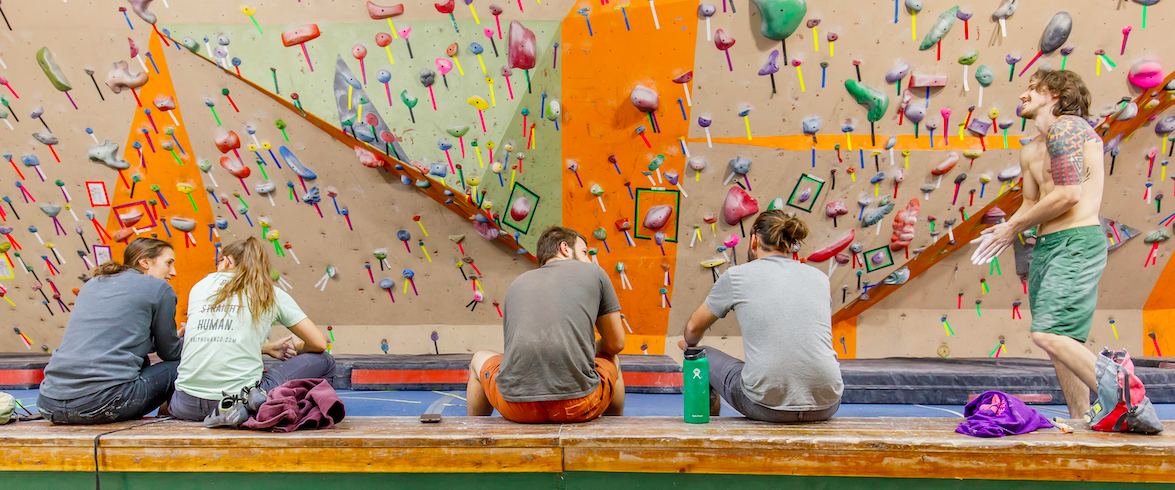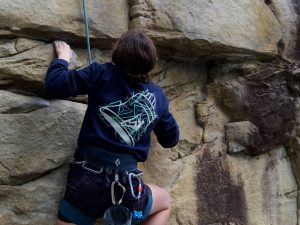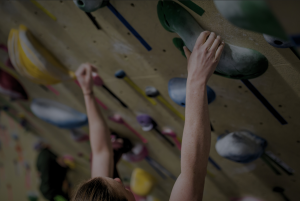What Does Cross-Body Tension Prevent?
Why do you need cross-body tension in climbing? To prevent barn-dooring, of course. Need a refresher on what barn dooring is? Read it here: ‘How to Prevent the Annoying ‘Barn Door’ in Climbing.’ Our previous article explained what barn dooring is and how to prevent it. In this article, I will be more specific in teaching cross-body tension on different types of walls; slab and vertical.
Cross-body tension leads to the principle that efficient climbing requires each movement to consist of shifting your weight over one foot, then pushing up, while holding on with the opposite hand. With this in mind, we can look at how this works from different angles. Let’s start on slab first.
Get Into the Barn Door Position on Slab
On a slab wall, find a handhold and a foothold that are roughly in line with one another, vertically speaking. Grab the handhold with your right hand, and place your right foot on the foothold.
Now, without grabbing a left handhold or putting your left foot on any hold, stand up on your right foot. This is a barn door position.
In most cases, the act of standing up in this position will cause your body to want to drift out and away from the wall. On a slab, you can get around this, typically by either leaning against the wall away from the holds you are on or pulling in (i.e., over-gripping) with your right hand.
In either case, however, a relatively light push with your left hand (or even leaning a bit to the right) will start the drift again, causing a need to hold on even tighter with your right hand.
In many cases, even this will not be enough and you will open up fully, eventually rotating off of your holds and taking a fall.
This is, of course, the position you want to avoid.
How Not to Barn Door on Slab
So, after you’ve done the practice described above, now try again, with one small change.
Place your left foot on the hold underneath your right hand. When you step up in this position you should notice that your body has no desire to swing out and away from the wall.
You should be able to stand up smoothly, and in balance, until your leg is straight and you can go for another handhold at your maximum reach. This is a cross-body position.
Deceptively simple.
Cross-Body Tension Position on Slab
With few exceptions, this is the basic configuration we want from any climbing move:
one foot doing the work of pushing up (called the motion point),
one hand–on the opposite side from the foot–providing balance and as little additional work as possible (the pivot point),
and the other leg out straight (either flagging or pushing off another foothold as opposition), while we reach for the next hold.
This is the fundamental position of cross-body tension.
On a slab, the failure to do this typically has fairly minor consequences, especially on larger holds and easier routes. Because we can lean into the wall, and even balance without hands, it is possible to reduce the barn door to only somewhat irritating, rather than a fall waiting to happen.
Of course, as routes get more difficult on slab, holds get smaller and further apart. This causes barn door positions to get progressively more strenuous, and therefore waste more energy.
How Not to Barn Door on Vertical Walls
When the angle turns to vertical, the negative impact of barn doors becomes much more apparent. It results in more frequent falls and more wasted energy.
At this angle, we no longer can fully balance on one foot without the aid of our hands. Gravity tries much harder to open that door if we fail to obey cross-body tension.
Here, we can get a better sense of the value of this new skill by picking an easy problem and trying it two ways.
First, by purposely only using barn door positions, and intentionally standing on the same side as the hold we are using for every move.
Second, do the exact same problem using cross-body tension for every move. If you were able to avoid a fall on your first try, you should still notice that the second try and using cross-body positions, took much less effort, and felt much more stable.
Cross-body Fundamentals
This leads us to a couple of phrases that may help you remember the fundamentals of cross-body tension.
You only need one foot to do a move. As we first discussed in the article on weight shifting, the work of moving up the wall, like moving up a staircase, centers on pushing up with your upper foot and using the lower foot for helping with balance (either through flagging or opposition).
Remember, in the vast majority of moves you will need to give up your lower foot in order to get your maximum reach.
Whichever hand you are planning to reach with, that is the foot you should be standing on. In the article coming up on basic sequencing, we will discuss several tricks to help you consistently use cross-body tension. For now, the fundamental principle is that your feet should follow your hands.
Decide which hold, and with which hand, you are going to reach, then make sure you are standing on that foot. The opposite approach, getting your feet situated somewhere “comfortable” and then reaching for the next hold, frequently leads to barn door positions.
Why Do You Need Cross-Body Tension in Climbing?
You need to incorporate cross-body tension in your climbing to prevent falls such as the barn door. Learning how to properly use cross-body tension will also make you a more efficient climber saving you wasted energy and improving your technique. Adhere to the cross-body fundamentals and climb on!
All material is reprinted with the permission of the author. Copyright 2022 David H. Rowland. All rights reserved.









